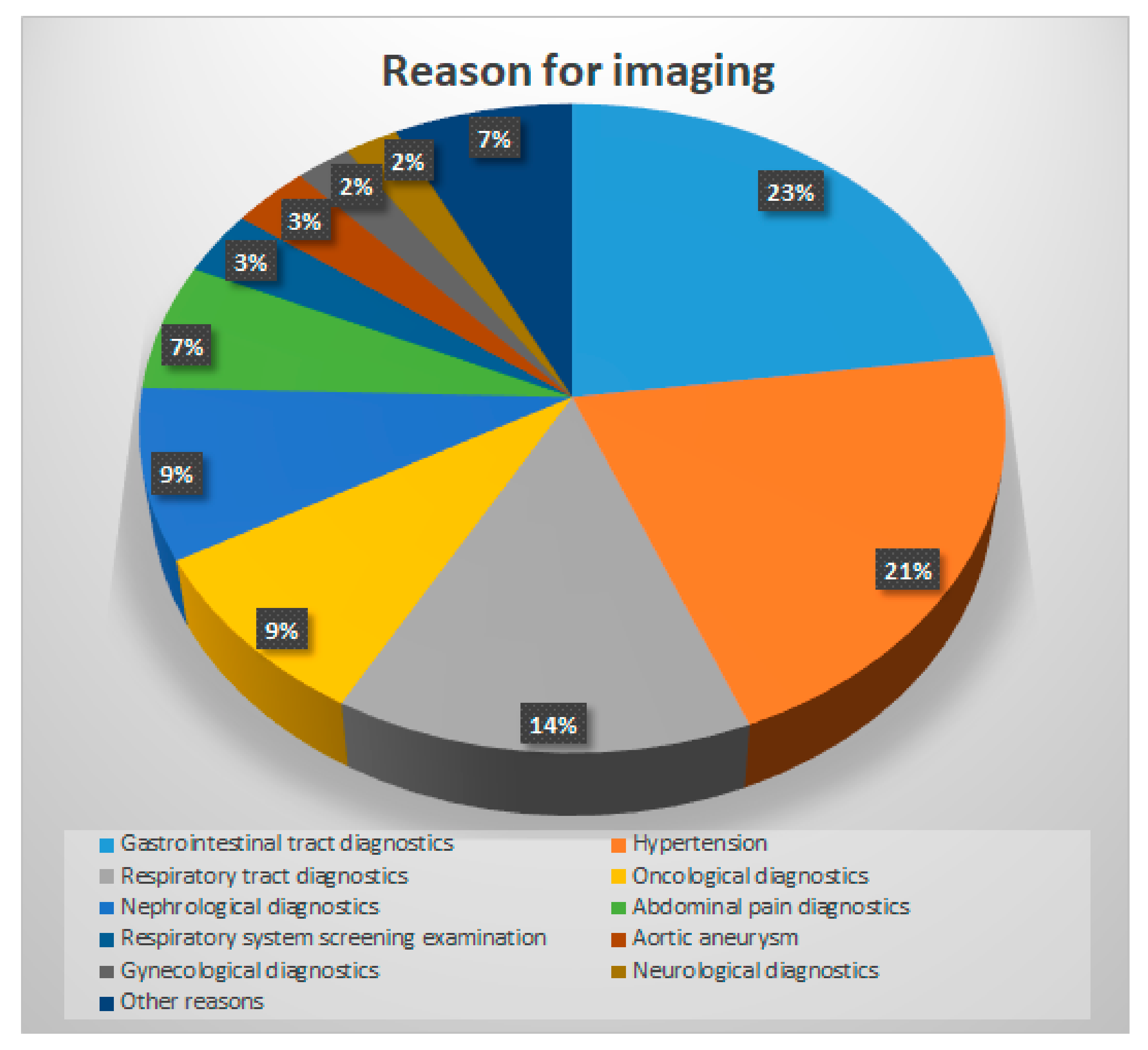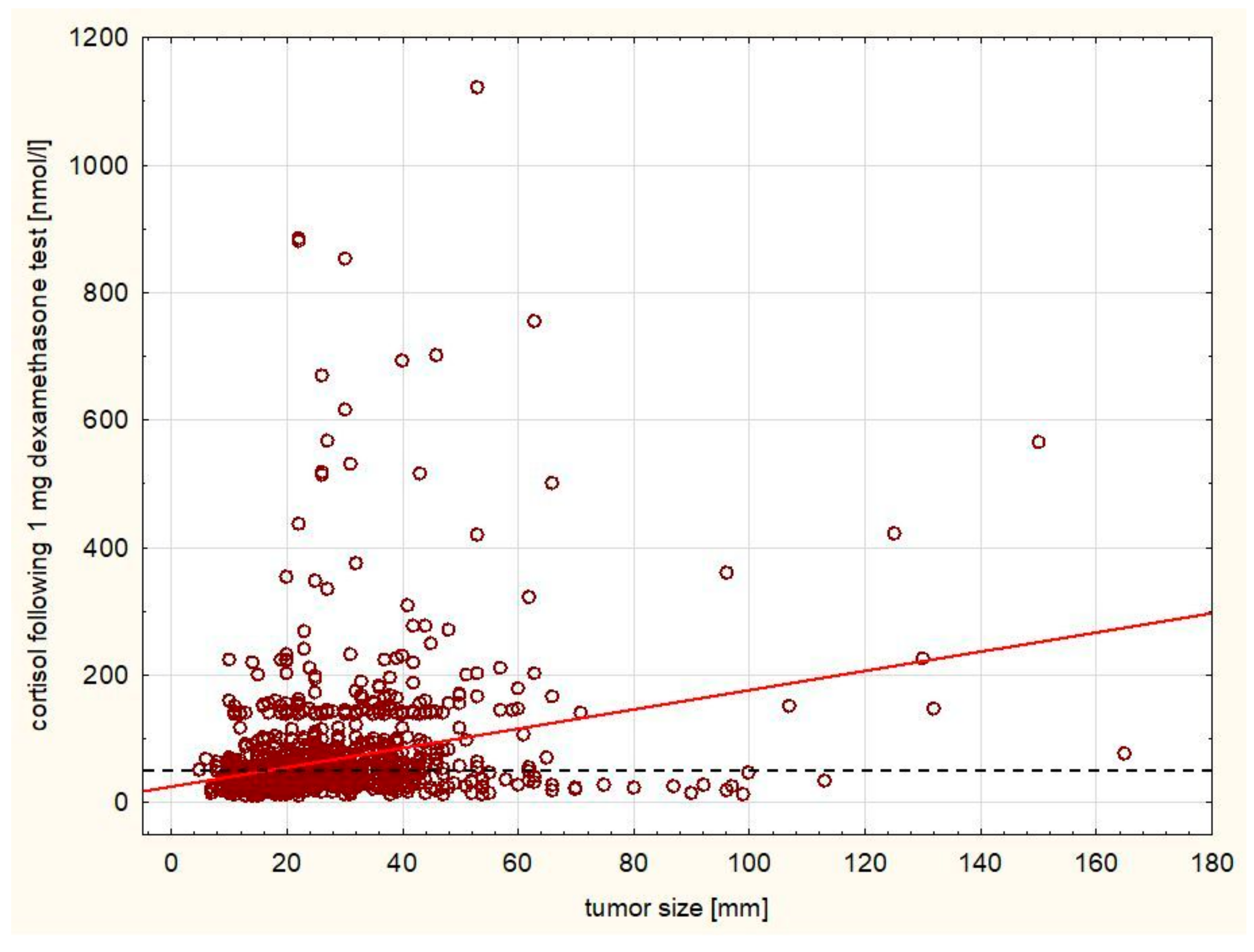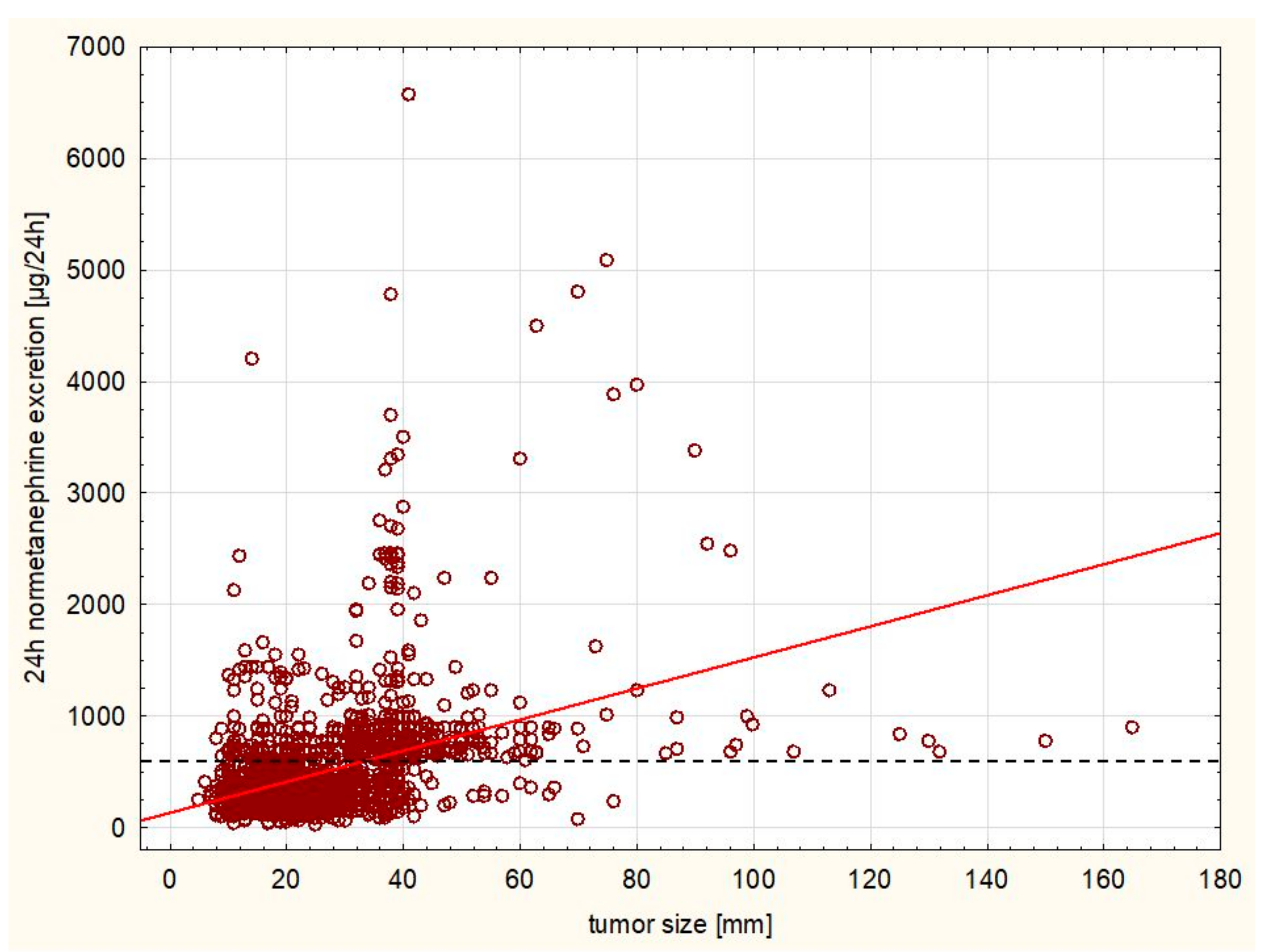Malignancy Risk and Hormonal Activity of Adrenal Incidentalomas in a Large Cohort of Patients from a Single Tertiary Reference Center
Abstract
1. Introduction
2. Materials and Methods
3. Results
4. Discussion
5. Conclusions
Author Contributions
Funding
Conflicts of Interest
References
- Geelhoed, G.W.; Druy, E.M. Management of the adrenal “incidentaloma”. Surgery 1982, 92, 866–874. [Google Scholar] [PubMed]
- Griffing, G.T. A-I-D-S: The new endocrine epidemic. J. Clin. Endocrinol. Metab. 1994, 79, 1530–1531. [Google Scholar] [PubMed]
- Cyranska-Chyrek, E.; Grzymislawska, M.; Ruchala, M. Diagnostic pitfalls of adrenal incidentaloma. Endokrynol. Pol. 2017, 68, 360–377. [Google Scholar] [PubMed]
- Young, W.F., Jr. Clinical practice. The incidentally discovered adrenal mass. N. Engl. J. Med. 2007, 356, 601–610. [Google Scholar] [CrossRef] [PubMed]
- Grumbach, M.M.; Biller, B.M.; Braunstein, G.D.; Campbell, K.K.; Carney, J.A.; Godley, P.A.; Harris, E.L.; Lee, J.K.; Oertel, Y.C.; Posner, M.C.; et al. Management of the clinically inapparent adrenal mass (“incidentaloma”). Ann. Intern. Med. 2003, 138, 424–429. [Google Scholar] [CrossRef]
- Arnaldi, G.; Boscaro, M. Adrenal incidentaloma. Best. Pract. Res. Clin. Endocrinol. Metab. 2012, 26, 405–419. [Google Scholar] [CrossRef] [PubMed]
- Mantero, F.; Masini, A.M.; Opocher, G.; Giovagnetti, M.; Arnaldi, G. Adrenal incidentaloma: An overview of hormonal data from the National Italian Study Group. Horm. Res. 1997, 47, 284–289. [Google Scholar] [CrossRef] [PubMed]
- Bednarczuk, T.; Bolanowski, M.; Sworczak, K.; Górnicka, B.; Cieszanowski, A.; Otto, M.; Ambroziak, U.; Pachucki, J.; Kubicka, E.; Babińska, A.; et al. Adrenal incidentaloma in adults-management recommendations by the Polish Society of Endocrinology. Endokrynol. Pol. 2016, 67, 234–258. [Google Scholar] [CrossRef]
- Fassnacht, M.; Arlt, W.; Bancos, I.; Dralle, H.; Newell-Price, J.A.; Tabarin, A.; Terzolo, M.; Tsagarakis, S.; Dekkers, O.M. Management of adrenal incidentalomas: European Society of Endocrinology Clinical Practice Guideline in collaboration with the European Network for the Study of Adrenal Tumors. Eur. J. Endocrinol. 2016, 175, G1–G34. [Google Scholar]
- Peppa, M.; Koliaki, C.; Raptis, S.A. Adrenal incidentalomas and cardiometabolic morbidity: An emerging association with serious clinical implications. J. Intern. Med. 2010, 268, 555–566. [Google Scholar] [CrossRef] [PubMed]
- Mansmann, G.; Lau, J.; Balk, E.; Rothberg, M.; Miyachi, Y.; Bornstein, S.R. The clinically inapparent adrenal mass: Update in diagnosis and management. Endocr. Rev. 2004, 25, 309–340. [Google Scholar] [CrossRef]
- Di Dalmazi, G.; Vicennati, V.; Garelli, S.; Casadio, E.; Rinaldi, E.; Giampalma, E.; Mosconi, C.; Golfieri, R.; Paccapelo, A.; Pagotto, U.; et al. Cardiovascular events and mortality in patients with adrenal incidentalomas that are either non-secreting or associated with intermediate phenotype or subclinical Cushing’s syndrome: A 15-year retrospective study. Lancet Diabetes Endocrinol. 2014, 2, 396–405. [Google Scholar] [CrossRef]
- Kim, B.Y.; Chun, A.; Kim, K.J.; Jung, C.H.; Kang, S.K.; Mok, J.O.; Kim, C.H. Clinical Characteristics and Metabolic Features of Patients with Adrenal Incidentalomas with or without Subclinical Cushing’s Syndrome. Endocrinol. Metab. 2014, 29, 457–463. [Google Scholar] [CrossRef]
- Tauchmanova, L.; Rossi, R.; Biondi, B.; Pulcrano, M.; Nuzzo, V.; Palmieri, E.-A.; Fazio, S.; Lombardi, G. Patients with subclinical Cushing’s syndrome due to adrenal adenoma have increased cardiovascular risk. J. Clin. Endocrinol. Metab. 2002, 87, 4872–4878. [Google Scholar] [CrossRef] [PubMed]
- Ribeiro Cavalari, E.M.; de Paula, M.P.; Arruda, M.; Carraro, N.; Martins, A.; de Souza, K.; Coelho, M.C.; de Morais, N.A.d.O.S.; Moraes, A.B.; Neto, L.V. Nonfunctioning adrenal incidentaloma: A novel predictive factor for metabolic syndrome. Clin. Endocrinol. 2018, 89, 586–595. [Google Scholar] [CrossRef]
- Blake, M.A.; Kalra, M.K.; Maher, M.M.; Sahani, D.V.; Sweeney, A.T.; Mueller, P.R.; Hahn, P.F.; Boland, G.W. Pheochromocytoma: An imaging chameleon. Radiographics 2004, 24 (Suppl. 1), S87–S99. [Google Scholar] [CrossRef] [PubMed]
- Blake, M.A.; Krishnamoorthy, S.K.; Boland, G.W.; Sweeney, A.T.; Pitman, M.B.; Harisinghani, M.; Mueller, P.R.; Hahn, P.F. Low-density pheochromocytoma on CT: A mimicker of adrenal adenoma. Am. J. Roentgenol. 2003, 181, 1663–1668. [Google Scholar] [CrossRef]
- Kopetschke, R.; Slisko, M.; Kilisli, A.; Tuschy, U.; Wallaschofski, H.; Fassnacht, M.; Ventz, M.; Beuschlein, F.; Reincke, M.; Reisch, N.; et al. Frequent incidental discovery of phaeochromocytoma: Data from a German cohort of 201 phaeochromocytoma. Eur. J. Endocrinol. 2009, 161, 355–361. [Google Scholar] [CrossRef] [PubMed]
- Donckier, J.E.; Michel, L. Phaeochromocytoma: State-of-the-art. Acta Chir. Belg. 2010, 110, 140–148. [Google Scholar] [CrossRef] [PubMed]
- Barzon, L.; Scaroni, C.; Sonino, N.; Fallo, F.; Gregianin, M.; Macri, C.; Boscaro, M. Incidentally discovered adrenal tumors: Endocrine and scintigraphic correlates. J. Clin. Endocrinol. Metab. 1998, 83, 55–62. [Google Scholar] [CrossRef]
- Mantero, F.; Arnaldi, G. Management approaches to adrenal incidentalomas. A view from Ancona, Italy. Endocrinol. Metab. Clin. N. Am. 2000, 29, 107–125. [Google Scholar] [CrossRef]
- Williams, J.S.; Williams, G.H.; Raji, A.; Jeunemaitre, X.; Brown, N.J.; Hopkins, P.N.; Conlin, P.R. Prevalence of primary hyperaldosteronism in mild to moderate hypertension without hypokalaemia. J. Hum. Hypertens. 2006, 20, 129–136. [Google Scholar] [CrossRef]
- Bernini, G.; Moretti, A.; Argenio, G.; Salvetti, A. Primary aldosteronism in normokalemic patients with adrenal incidentalomas. Eur. J. Endocrinol. 2002, 146, 523–529. [Google Scholar] [CrossRef] [PubMed][Green Version]
- Mulatero, P.; Stowasser, M.; Loh, K.-C.; Fardella, C.E.; Gordon, R.D.; Mosso, L.; Gomez-Sanchez, C.E.; Veglio, F.; Young, W.F. Increased diagnosis of primary aldosteronism, including surgically correctable forms, in centers from five continents. J. Clin. Endocrinol. Metab. 2004, 89, 1045–1050. [Google Scholar] [CrossRef]
- Stowasser, M.; Gordon, R.D.; Gunasekera, T.G.; Cowley, D.C.; Ward, G.; Archibald, C.; Smithers, B.M. High rate of detection of primary aldosteronism, including surgically treatable forms, after ‘non-selective’ screening of hypertensive patients. J. Hypertens. 2003, 21, 2149–2157. [Google Scholar] [CrossRef]
- Benchetrit, S.; Bernheim, J.; Podjarny, E. Normokalemic hyperaldosteronism in patients with resistant hypertension. Isr. Med. Assoc. J. 2002, 4, 17–20. [Google Scholar]
- Walz, M.K.; Gwosdz, R.; Levin, S.L.; Alesina, P.F.; Suttorp, A.-C.; Metz, K.A.; Wenger, F.A.; Petersenn, S.; Mann, K.; Schmid, K.W.; et al. Retroperitoneoscopic adrenalectomy in Conn’s syndrome caused by adrenal adenomas or nodular hyperplasia. World J. Surg. 2008, 32, 847–853. [Google Scholar] [CrossRef] [PubMed]
- Doppman, J.L.; Gill, J.R., Jr.; Miller, D.L.; Chang, R.; Gupta, R.; Friedman, T.C.; Choyke, P.L.; Feuerstein, I.M.; Dwyer, A.J.; Jicha, D.L. Distinction between hyperaldosteronism due to bilateral hyperplasia and unilateral aldosteronoma: Reliability of CT. Radiology 1992, 184, 677–682. [Google Scholar] [CrossRef]
- McAlister, F.A.; Lewanczuk, R.Z. Primary hyperaldosteronism and adrenal incidentaloma: An argument for physiologic testing before adrenalectomy. Can. J. Surg. 1998, 41, 299–305. [Google Scholar] [PubMed]
- Icard, P.; Goudet, P.; Charpenay, C.; Andréassian, B.; Carnaille, B.; Chapuis, Y.; Cougard, P.; Henry, J.-F.; Proye, C. Adrenocortical carcinomas: Surgical trends and results of a 253-patient series from the French Association of Endocrine Surgeons study group. World J. Surg. 2001, 25, 891–897. [Google Scholar] [CrossRef] [PubMed]
- Herrera, M.F.; Grant, C.S.; van Heerden, J.A.; Sheedy, P.F.; Ilstrup, D.M. Incidentally discovered adrenal tumors: An institutional perspective. Surgery 1991, 110, 1014–1021. [Google Scholar] [PubMed]
- Bülow, B.; Ahrén, B. Swedish Research Council Study Group of Endocrine Abdominal Tumours. Adrenal incidentaloma—Experience of a standardized diagnostic programme in the Swedish prospective study. J. Intern. Med. 2002, 252, 239–246. [Google Scholar] [CrossRef] [PubMed]
- Wajchenberg, B.L.; Albergaria Pereira, M.A.; Medonca, B.B.; Latronico, A.C.; Campos Carneiro, P.; Alves, V.A.; Zerbini, M.C.; Liberman, B.; Carlos Gomes, G.; Kirschner, M.A. Adrenocortical carcinoma: Clinical and laboratory observations. Cancer 2000, 88, 711–736. [Google Scholar] [CrossRef]
- Zeiger, M.A.; Thompson, G.B.; Duh, Q.Y.; Hamrahian, A.H.; Angelos, P.; Elaraj, D.; Fishman, E.; Kharlip, J. American Association of Clinical Endocrinologists; American Association of Endocrine Surgeons. The American Association of Clinical Endocrinologists and American Association of Endocrine Surgeons medical guidelines for the management of adrenal incidentalomas. Endocr. Pract. 2009, 15 (Suppl. 1), 1–20. [Google Scholar]
- Sturgeon, C.; Shen, W.T.; Clark, O.H.; Duh, Q.Y.; Kebebew, E. Risk assessment in 457 adrenal cortical carcinomas: How much does tumor size predict the likelihood of malignancy? J. Am. Coll. Surg. 2006, 202, 423–430. [Google Scholar] [CrossRef]
- Duh, Q.Y. Adrenal incidentalomas. Br. J. Surg. 2002, 89, 1347–1349. [Google Scholar] [CrossRef] [PubMed]
- Thompson, G.B.; Young, W.F., Jr. Adrenal incidentaloma. Curr. Opin. Oncol. 2003, 15, 84–90. [Google Scholar] [CrossRef]
- Dackiw, A.P.; Lee, J.E.; Gagel, R.F.; Evans, D.B. Adrenal cortical carcinoma. World J. Surg. 2001, 25, 914–926. [Google Scholar] [CrossRef]
- Terzolo, M.; Ali, A.; Osella, G.; Mazza, E. Prevalence of adrenal carcinoma among incidentally discovered adrenal masses. A retrospective study from 1989 to 1994. Arch. Surg. 1997, 132, 914–919. [Google Scholar] [CrossRef]
- Copeland, P.M. The incidentally discovered adrenal mass. Ann. Surg. 1984, 199, 116–122. [Google Scholar] [CrossRef]
- Birsen, O.; Akyuz, M.; Dural, C.; Aksoy, E.; Aliyev, S.; Mitchell, J.; Siperstein, A.; Berber, E. A new risk stratification algorithm for the management of patients with adrenal incidentalomas. Surgery 2014, 156, 959–965. [Google Scholar] [CrossRef] [PubMed]





| Diagnosed Type of Hormonal Activity | Diagnostic Criteria |
|---|---|
| Possible autonomous cortisol secretion | Diagnosed if at least three out of four mentioned features were present: (1) ACTH suppression < 7.20 pg/mL (2) disturbed circadian rhythm of cortisol secretion (lack of decrease in cortisol level by at least 50% at 6 p.m. in comparison to 8 a.m.) (3) increased 24 h urinary cortisol excretion (by at least two times above upper normal limit) (4) lack of cortisol suppression during 1 mg dexamethasone test (cortisol level at 8 a.m. >50 nmol/L) |
| Autonomous cortisol secretion | Diagnosed if all four features mentioned above were present |
| Pheochromocytoma | Diagnosed if 24 h urinary excretion of catecholamines metabolites (normetanephrine and/or metanephrine) was significantly increased (by at least two times above upper normal limit) |
| Primary hyperaldosteronism | Diagnosed when all features below were present: (1) increased concentration of aldosterone at rest (2) lack of significant decrease of aldosterone level during tilt test (3) plasma renin activity below normal range (4) Aldosterone-to-renin ratio (ARR) > 20 |
| Adrenal hyperandrogenism | Increased DHEA-S concentration (above normal range defined according to age) |
| Histopathological Diagnosis | Number (%) of Patients |
|---|---|
| Adrenocortical adenoma | 106 (49.5%) |
| Pheochromocytoma | 46 (21.5%) |
| Adrenocortical carcinoma | 18 (8.4%) |
| Renal cell cancer | 10 (4.7%) |
| Follicular hyperplasia | 6 (2.8%) |
| Neurofibroma (3), Hamartoma (3) | 6 (2.8%) |
| Calcified cyst | 5 (2.4%) |
| Myelolipoma | 5 (2.4%) |
| Metastasis from Lung Cancer (2), Metastasis from Breast Cancer (2) | 4 (1.9%) |
| Oncocytoma | 2 (0.9%) |
| Angiomyolipoma | 2 (0.9%) |
| Ganglioneuroma | 2 (0.9%) |
| Choristoma (1), Liposarcoma (1) | 2 (0.9%) |
| Total | 214 |
© 2019 by the authors. Licensee MDPI, Basel, Switzerland. This article is an open access article distributed under the terms and conditions of the Creative Commons Attribution (CC BY) license (http://creativecommons.org/licenses/by/4.0/).
Share and Cite
Cyranska-Chyrek, E.; Szczepanek-Parulska, E.; Olejarz, M.; Ruchala, M. Malignancy Risk and Hormonal Activity of Adrenal Incidentalomas in a Large Cohort of Patients from a Single Tertiary Reference Center. Int. J. Environ. Res. Public Health 2019, 16, 1872. https://doi.org/10.3390/ijerph16101872
Cyranska-Chyrek E, Szczepanek-Parulska E, Olejarz M, Ruchala M. Malignancy Risk and Hormonal Activity of Adrenal Incidentalomas in a Large Cohort of Patients from a Single Tertiary Reference Center. International Journal of Environmental Research and Public Health. 2019; 16(10):1872. https://doi.org/10.3390/ijerph16101872
Chicago/Turabian StyleCyranska-Chyrek, Ewa, Ewelina Szczepanek-Parulska, Michal Olejarz, and Marek Ruchala. 2019. "Malignancy Risk and Hormonal Activity of Adrenal Incidentalomas in a Large Cohort of Patients from a Single Tertiary Reference Center" International Journal of Environmental Research and Public Health 16, no. 10: 1872. https://doi.org/10.3390/ijerph16101872
APA StyleCyranska-Chyrek, E., Szczepanek-Parulska, E., Olejarz, M., & Ruchala, M. (2019). Malignancy Risk and Hormonal Activity of Adrenal Incidentalomas in a Large Cohort of Patients from a Single Tertiary Reference Center. International Journal of Environmental Research and Public Health, 16(10), 1872. https://doi.org/10.3390/ijerph16101872





